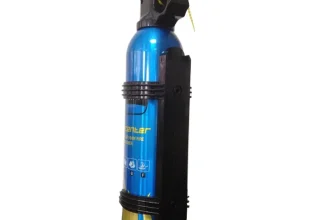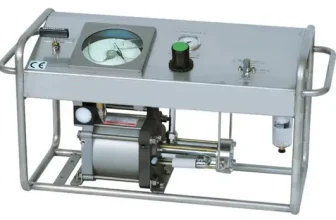This article is for informational purposes only and should not be used as a substitute for professional advice or services. If you have any concerns about fire safety, contact a qualified fire safety professional immediately.
Cooking oil and grease fires are some of the most common fire hazards in the home. It’s important to be prepared for these types of fires, as they can quickly spread and cause a lot of damage. The key to extinguishing a cooking oil fire is to use the right fire extinguisher.
Knowing which fire extinguisher to use will help you respond quickly and effectively before it gets out of control. In this blog post, we’ll discuss what type of fire extinguishers should be used for cooking oil/grease fires so that you can stay safe when faced with such an emergency situation.
Understand Available Fire Extinguishers
The fire extinguishers that are available to put out home kitchen cooking oil and grease fires are known as Class B fire extinguishers.
Please note that many fire extinguishers have multiple ratings for different types of fires, but as long as you see a rating of class B the extinguisher is good for a cooking oil or grease fire in a home kitchen.
Class B fire extinguishers are specifically used to combat flammable liquid fires. They work by creating a film on the surface of the burning liquid which then smothers the flame and prevents it from spreading.
Common types of Class B fire extinguishers include foam, dry powder, and carbon dioxide (CO2) extinguishers.
Dry powder extinguishers are effective against flammable liquids such as oil, paint, petrol, and paraffin.
Foam extinguishers are best used for tackling liquefied petroleum gas (LPG), petrol, and diesel fires.
Carbon dioxide (CO2) extinguishers are suitable for electrical equipment, solvents, and other flammable liquids.
Dry Powder Fire Extinguishers
Dry powder fire extinguishers are a common option for tackling cooking oil and grease fires in home kitchens and may be more readily available than other types of class B-rated fire extinguishers.
Class B dry powder fire extinguishers work by coating the burning liquid with a mixture of fine powders which separate and smother the fuel, depriving it of oxygen.
The particles also possess a cooling effect, so they lower the temperature of the fuel to prevent any further combustion. Dry powder extinguishers are suitable for tackling Class B fires involving flammable liquids such as paint, petrol, oils, and paraffin.
There is another class of fire extinguishers, class K, that are usually used in commercial kitchens.
These class K extinguishers are usually much more expensive than class B extinguishers, and they use a liquid instead of a dry powder. They can cause more damage to things in the area when they are used.
Make Sure to Read All Instructions
When it comes to fire safety, one of the most important steps is to make sure you read the fire extinguisher labels and instructions before use.
Fire extinguishers are designed to smother a fire and help prevent damage from occurring, but they can also be dangerous if used improperly.
Before using a fire extinguisher, familiarize yourself with all of the instructions, including how to hold it, when and where to aim it, and how much pressure to use.
Additionally, make sure you understand fire safety protocols in case your fire extinguisher doesn’t work or the fire spreads beyond your control.
Have Your Extinguisher Ready
Having a fire extinguisher available and ready to use is essential for fire safety in any home or workplace. It is important to ensure that fire extinguishers are properly maintained and readily accessible in the event of a fire emergency.
Additionally, fire extinguishers should be inspected regularly and replaced when necessary. Knowing which fire extinguisher to use for a cooking oil or grease fire can help you respond quickly and effectively in the event of an emergency situation.
Make Sure Everyone Knows the Extinguisher Location
Making sure fire extinguishers are properly located and understood is an essential fire safety step for any home or workplace. Everyone living in the home or working in the workplace must know where fire extinguishers are located and how to use them.
Make sure all fire extinguishers are clearly labeled and located in easy-to-reach places.
It is also important to make sure that fire safety training is conducted regularly for everyone who may be potentially exposed to fire hazards. This will help ensure that people know how to use fire extinguishers properly, as well as other fire safety measures.
Check for Fire Extinguisher Regularly
A fire extinguisher typically has an expected lifespan of about 12 years, however, this may vary depending on the type of fire extinguisher and how it is used. The fire extinguisher must be recharged or replaced after use in order to ensure optimal fire safety.
Fire extinguishers are critical fire safety tools and must be properly maintained in order to work effectively in the event of an emergency. This means it is important to regularly check fire extinguishers for expiration and make sure they have not become outdated.
Fire extinguishers have expiration dates printed on them, so it is easy to know when they need to be replaced.
When a fire extinguisher has passed its expiration date, it should be replaced immediately.
Additionally, fire extinguisher pressure gauges should be checked monthly to ensure that fire extinguishers are fully charged and ready for use.
It is important to recognize the signs and symptoms of an expired fire extinguisher or one that may not operate properly when needed, such as corrosion or rust on the fire extinguisher body, missing or illegible labels, clogged nozzles, discharged fire extinguisher contents, and no pressure gauge reading.
Final Thoughts
By following these simple steps and having a fire extinguisher on hand that is specifically designed for cooking oil and grease fires, you can be prepared for any fire emergency. Knowing the right fire extinguisher to use can help you respond quickly and effectively when faced with a fire hazard in your home or workplace.
Keep in mind that fire safety isn’t just about having fire extinguishers on hand, but also about being aware of fire hazards and having an evacuation plan in place. With the right fire safety knowledge, you can help keep your home and workplace safe from fire hazards.





